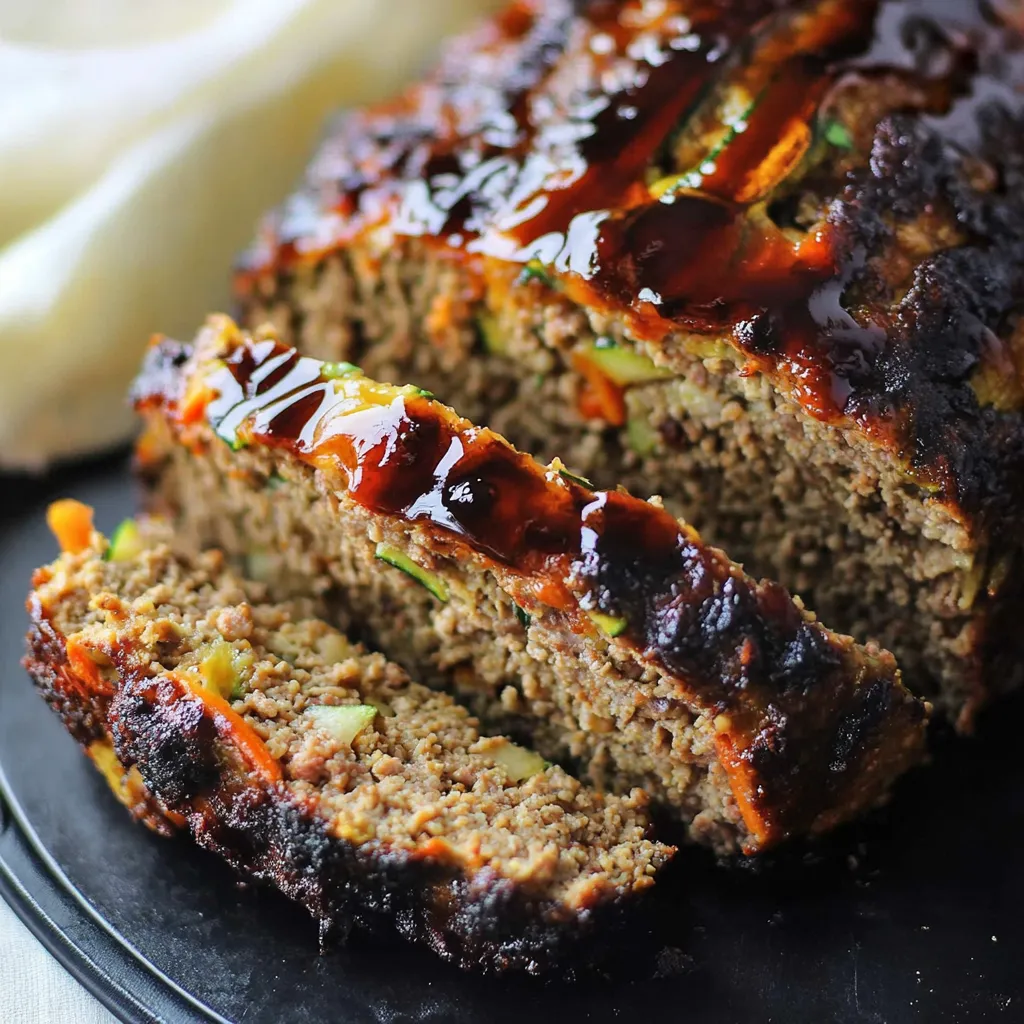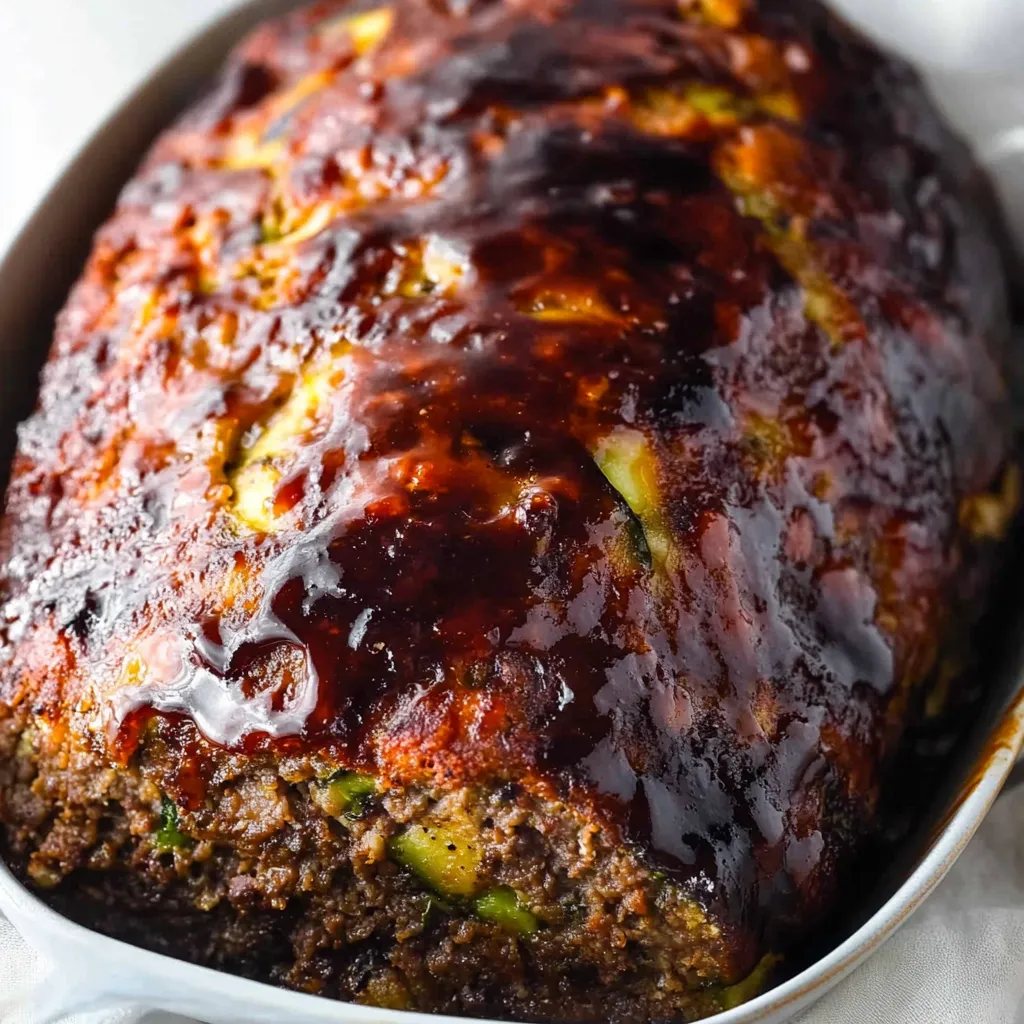 Pin it
Pin it
This elevated balsamic meatloaf transforms a classic comfort food into something truly special with hidden vegetables that add moisture and nutrition while a glossy balsamic-ketchup glaze caramelizes to perfection during baking. The combination of ground beef and pork creates incredibly juicy texture, while grated zucchini, carrots, and onions virtually disappear into the mixture but contribute amazing flavor and keep every slice moist and tender. That gorgeous caramelized glaze on top provides the perfect sweet-tangy finish that makes this meatloaf taste like it came from an upscale restaurant.
I developed this recipe when I was trying to find ways to add more vegetables to our family meals without resistance from my kids. The grated vegetables completely disappear into the meat mixture, adding moisture and nutrition without any noticeable texture changes. That first time I made it, my husband couldn't stop raving about how much better it was than regular meatloaf, and the kids had no idea they were eating carrots and zucchini. Now it's become our go-to comfort food dinner, and I love how that beautiful caramelized glaze makes it feel special enough for company.
Essential Ingredients and Selection Tips:
- Ground beef and pork combination: Use 85/15 or 80/20 ground beef with ground pork for the perfect fat ratio and flavor
- Fresh vegetables: Choose firm zucchini and carrots; grate them finely so they integrate seamlessly into the mixture
- Panko breadcrumbs: The larger texture works better than regular breadcrumbs for binding without making the meatloaf dense
- Quality balsamic vinegar: Use real balsamic vinegar rather than flavored imitations for the best glaze flavor
- Good ketchup: Choose a brand you actually like eating since it's a major flavor component in the glaze
- Fresh garlic: Pressed or minced fresh garlic provides much better flavor than powder
Step-by-Step Instructions:
- Prepare vegetables for seamless integration:
- Heat olive oil in a large skillet over medium-high heat. Add finely diced onion, grated carrot, and grated zucchini along with pressed garlic, salt, and pepper. Sauté for 4-5 minutes, stirring occasionally, until the vegetables soften and much of the moisture evaporates. This pre-cooking step is crucial for preventing excess moisture in the finished meatloaf while concentrating the vegetable flavors.
- Set up for optimal mixing:
- Remove the sautéed vegetables from heat and let them cool for 5-10 minutes while you preheat the oven to 400°F and prepare your other ingredients. The vegetables need to cool enough that they won't cook the eggs when mixed together. Line a rimmed baking sheet with parchment paper for easy cleanup and to prevent sticking.
- Combine meat mixture expertly:
- In a large mixing bowl, combine the ground beef, ground pork, panko breadcrumbs, eggs, and half of both the ketchup and balsamic vinegar (3 tablespoons each). Season generously with salt and pepper. Add the cooled sautéed vegetables to the bowl, distributing them evenly throughout the meat mixture.
- Mix with proper technique:
- Using clean hands (which works best) or a large spoon, gently mix all ingredients until just combined and evenly distributed. Don't overmix, which would create a dense, tough texture. The mixture should look cohesive and hold together when squeezed, resembling a large meatball in consistency and appearance.
- Shape for even cooking:
- Transfer the meat mixture to the center of your prepared baking sheet and shape it into a rectangular loaf about 9 inches long, 5 inches wide, and 3 inches high. Pack it firmly but gently to ensure it holds together during cooking and slicing. Make sure the height is consistent throughout so it cooks evenly.
- Create the signature glaze:
- In a small bowl, whisk together the remaining balsamic vinegar and ketchup until smooth. Using a pastry brush or spoon, coat the entire surface of the meatloaf with this glaze, including the top and sides. Don't worry if some drips onto the pan - those bits will caramelize beautifully during baking.
- Bake to perfect doneness:
- Place the glazed meatloaf in the preheated oven and bake for 65-70 minutes, until the internal temperature reaches 160°F when tested with an instant-read thermometer in the center. The glaze should be deeply caramelized and glossy, and the edges should be beautifully browned.
- Rest for optimal slicing:
- Remove the meatloaf from the oven and let it rest for 10-15 minutes before slicing. This resting period allows the juices to redistribute and the structure to firm up, resulting in clean slices that hold together perfectly. Use a sharp knife to cut into thick slices for serving.
 Pin it
Pin it
The ingredient I'm most excited about in this recipe is definitely the combination of balsamic vinegar and ketchup for the glaze. When I first heard about this combination, I was skeptical because it seemed too simple, but the magic happens during baking when the sugars caramelize and the acid from the balsamic vinegar balances the sweetness of the ketchup perfectly. The result is this gorgeous, glossy glaze that tastes incredibly sophisticated and complex. Those little crispy bits that form around the edges are absolutely addictive - my family fights over them every time we make this meatloaf.
Vegetable Integration and Moisture Management
The key to successfully incorporating vegetables into meatloaf lies in proper preparation and moisture control. Grating the vegetables finely ensures they distribute evenly and virtually disappear into the finished product, while pre-cooking removes excess water that could make the meatloaf soggy. The vegetables serve multiple purposes: they add nutrition, contribute natural moisture for tenderness, and provide subtle flavor enhancement without being detectable to vegetable-averse family members.
Meat Selection and Fat Content Balance
Using a combination of ground beef and pork creates superior flavor and texture compared to beef alone. The pork adds richness and helps keep the meatloaf moist, while the beef provides the familiar flavor most people expect. The 85/15 or 80/20 fat ratio is optimal because it provides enough fat for moisture and flavor without making the meatloaf greasy, especially when cooking on a sheet pan where excess fat can drain away.
Glaze Chemistry and Caramelization
The balsamic-ketchup glaze works through the Maillard reaction and caramelization of natural sugars during the long baking time. The ketchup provides sugars that caramelize beautifully, while the balsamic vinegar adds acidity that balances sweetness and contributes to the complex flavor development. Applying the glaze before baking allows for maximum caramelization and creates those coveted crispy edges.
Shaping and Cooking Technique
Using a sheet pan instead of a traditional loaf pan allows for better heat circulation and browning on all surfaces, creating a more flavorful exterior. The rectangular shaping ensures even cooking while providing more surface area for the delicious glaze. Proper packing creates structural integrity that results in clean slices while maintaining the tender, moist interior texture.
Temperature Control and Food Safety
Achieving the perfect balance of food safety and optimal texture requires understanding proper internal temperatures for ground meat mixtures. The 160°F target ensures safety while preventing overcooking that would result in dry, tough meatloaf. Using an instant-read thermometer takes the guesswork out of doneness and prevents the disappointment of dry results.
Resting and Serving Optimization
The resting period after baking is crucial for both texture and presentation. It allows the proteins to relax and reabsorb juices, while the structure firms up enough for clean slicing. This technique separates home cooks who achieve restaurant-quality results from those whose meatloaf falls apart when served.
This balsamic meatloaf has completely changed how my family thinks about this classic comfort food because it proves that traditional recipes can be elevated without losing their homey appeal. The hidden vegetables make me feel good about serving it regularly, while that gorgeous caramelized glaze makes it special enough for company dinners. Every time I make it, I'm reminded that some of the best cooking happens when you take familiar flavors and techniques and add just enough sophistication to make them exciting again. It's become one of those recipes that makes everyone at the table happy - from kids who love the familiar comfort food appeal to adults who appreciate the complex flavors and beautiful presentation.
Frequently Asked Questions
- → Can I use just ground beef instead of beef and pork?
- Yes, you can use 2 pounds of ground beef, but the pork adds extra moisture and flavor to the meatloaf.
- → How do I know when the meatloaf is done?
- Use a meat thermometer to check that the internal temperature reaches 160°F in the center of the loaf.
- → Why do I need to let the meatloaf rest before slicing?
- Resting for 10 minutes helps the juices redistribute and prevents the meatloaf from falling apart when you cut it.
- → Can I make this meatloaf ahead of time?
- Yes, you can form the loaf and refrigerate it overnight before baking. Add 10-15 minutes to the cooking time if baking from cold.
- → What vegetables can I substitute for zucchini and carrot?
- Try bell peppers, mushrooms, or celery. Just make sure to dice them small and sauté until tender before mixing in.
- → How should I store leftover meatloaf?
- Store covered in the refrigerator for up to 4 days. Reheat slices in the microwave or oven until warmed through.
